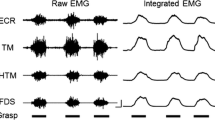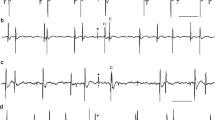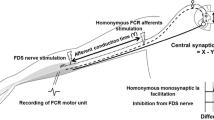Summary
Motor unit firing behavior in human first dorsal interosseous (FDI) muscle was studied during controlled constant force isometric contractions. The threshold at which motor units were recruited and the mean firing rate at 50% of maximal voluntary contraction (MVC) were evaluated following stimulation of the skin area over the second digit. Stimulation of cutaneous receptors tended to increase the recruitment threshold of most of the motor units recruited under 20% MVC, while high-threshold motor units (those recruited over 30% MVC) generally exhibited a decrease in recruitment threshold. Less dramatic changes in motor unit firing rates were observed, but those motor units recruited over 30% MVC exhibited some increase in firing rate. The relationship between the change in recruitment threshold and change in motor unit firing rate is not rigid and seems to be susceptible to considerable synaptic noise.
Similar content being viewed by others
References
Binder MD, Mendell LM (1990) The segmental motor system. Oxford, New York
Burke JR, Kamen G, Koceja DM (1989) Long-latency enhancement of quadriceps excitability from stimulation of skin afferents in young and old adults. J Gerontol 44:M158-M163
Burke RE (1973) On the central nervous system control of fast and slow twitch motor units. In: Desmedt JE (eds) New developments in electromyography and clinical neurophysiology, Vol 3. Karger, Basel, pp 69–94
Burke RE (1981) Motor units: anatomy, physiology, and functional organization. In: Brooks VB (eds) Handbook of physiology, Sect 1. The nervous system, Vol II. Am Physiol Soc, Bethesda MD, pp 345–422
Burke RE, Jankowska E, ten Bruggencate G (1970) A comparison of peripheral and rubrospinal synaptic input to slow and fasttwitch motor units of triceps surae. J Physiol (Lond) 207:709–732
Clamann HP, Gillies JD, Henneman E (1974) Effects of inhibitory inputs on critical firing level and rank-order of motoneurons. J Neurophysiol 37:1350–1360
Clamann HP, Henneman E (1976) Electrical measurement of axon diameter and its use in relating motoneuron size to critical firing level. J Neurophysiol 39:844–856
Datta AK, Stephens JA (1979) The effect of digital nerve stimulation on motor unit interspike intervals recorded during voluntary contraction of the first dorsal interosseous muscle in man. J Physiol (Lond) 292:16–17P
Datta AK, Stephens JA (1981) The effect of digital nerve stimulation on the firing of motor units in human first dorsal interosseous muscle. J Physiol (Lond) 318:501–510
Desmedt JE, Godaux E (1981) Spinal motoneuron recruitment in man: rank deordering with direction but not with speed of voluntary movement. Science 214:933–936
Garnett R, Stephens JA (1979) Changes in the recruitment threshold of motor units in human first dorsal interosseous muscle produced by skin stimulation. J Physiol (Lond) 282:13P
Garnett R, Stephens JA (1981) Changes in the recruitment threshold of motor units in human first dorsal interosseous muscle produced by skin stimulation. J Physiol (Lond) 311:463–473
Grimby L, Hannerz J (1976) Disturbances in voluntary recruitment order of low and high frequency motor units on blockades of proprioceptive afferent activity. Acta Physiol Scand 96:207–216
Hallin RG, Torebjork HE (1973) Electrically induced A and C fibre responses in intact human skin nerves. Exp Brain Res 16:309–320
Henneman E, Somjen G, Carpenter DC (1965) Functional significance of cell size in spinal motoneurons. J Neurophysiol 28:560–580
Henneman E, Shahani BI. Young RR (1976) Voluntary control of human motor units. In: Shahani M (eds) The motor system:neurophysiology and muscle mechanisms. Elsevier, New York, pp 73–78
Hultborn H, Wigstrom H, Wangberg B (1975) Prolonged activation of soleus motoneurons following a conditioning train on soleus la afferents — a case for a reverberating loop? Neurosci Lett 1:147–152
Kanda K, Burke RE, Walmsley B (1977) Differential control of fast and slow twitch motor units in the decerebrate cat. Exp Brain Res 29:57–74
Kanda K, Desmedt JE (1983) Cutaneous facilitation of large motor units and motor control of human fingers in precision grip. In: Desmedt JE (eds) Motor control mechanisms in health and disease. Advances in neurology, Vol 29. Raven, New York, pp253–261
LeFever RS, Xenakis AP, De Luca CJ (1982) A procedure for decomposing the myoelectric signal into its constituent action potentials, Part 2. Execution and test for accuracy. IEEE Trans Biomed Eng 29:158–164
Mambrito B, De Luca CJ (1983) Acquisition and decomposition of the EMG signal. In: Desmedt JE (eds) Computer-aided electromyography. Progress in clinical neurophysiology, Vol 10. Karger, Basel, pp 52–72
Mambrito B, De Luca CJ (1984) A technique for the detection, decomposition and analysis of the EMG signal. Electroencephal Clin Neurophysiol 58:175–188
McClean MD (1984) Recruitment threshold of lower-lip motor units with changes in movement direction. J Speech Hearing Res 27:6–12
Mizote M (1982) The effect of digital nerve stimulation on recruitment order of motor units in the first deep lumbrical muscle of the cat. Brain Res 248:245–255
Nardone A, Romano C, Schieppati M (1989) Selective recruitment of high-threshold human motor units during voluntary isotonic lengthening of active muscles. J Physiol (Lond) 409:451–471
Person RS (1974) Rhythmic activity of a group of human motoneurones during voluntary contraction of a muscle. Electroencephal Clin Neurophysiol 36:585–595
Sabbahi MA, De Luca CJ (1982) Topical anesthesia: modulation of the monosynaptic reflexes by the desensitization of the skin. Electroencephal Clin Neurophysiol 54:677–688
Spanton SG, Prestwich GD (1981) Sensory and motor functions of spinal cord substance P. Science 214:1361–1364
Stashuk D, De Luca CJ (1989) Update on the decomposition and analysis of EMG signals In: Desmedt JE (eds) Computer-aided electromyography and expert systems. Clinical neurophysiology updates, Vol 2. Elsevier, New York, pp 39–53
Stein RB, Bertoldi R (1981) The size principle: a synthesis of neurophysiological data. In: Desmedt JE (eds) Motor unit types, recruitment and plasticity in health and disease. Progress in clinical neurophysiology, Vol 9. Karger, Basel, pp 85–96
Suzuki S, Hayami A, Suzuki M, Watanabe S, Hutton RS (1988) Alterations in human motor unit force thresholds by prior muscle activity and stretch. Med Science Sports Exerc 20 (Suppl):S54
Suzuki S, Hayami A, Suzuki M, Watanabe S, Hutton RS (1989) Successive muscle contractions decrease recruitment force thresholds in single motor units. Abstr Soc Neurosci 15:915
Suzuki S, Hayami A, Suzuki M, Watanabe S, Hutton RS (1990) Reductions in recruitment force thresholds in human single motor units by successive voluntary contractions. Exp Brain Res 82:227–230
Ter Haar Romeny BM, Denier JJ, Vander Gon CC, Gielen AM(1982) Changes in recruitment order of the motor units in the human biceps muscle. Exp Neurol 78:360–368
Thomas JS, Ross BH, Calancie B (1987) Human motor-unit recruitment during isometric contractions and repeated dynamic movements. J Neurophysiol 57:311–324
Thomas JS, Schmidt EM, Hambrecht FT (1978) Facility of motor unit control during tasks defined directly in terms of unit behaviors. Exp Neurol 59:384–395
Veltink PH, Van Alste JA, Boom HBK (1988) Influences of stimulation conditions on recruitment of myelinated nerve fibers: a model study. IEE Trans Biomed Eng 35:917–924
Author information
Authors and Affiliations
Rights and permissions
About this article
Cite this article
Masakado, Y., Kamen, G. & De Luca, C.J. Effects of percutaneous stimulation on motor unit firing behavior in man. Exp Brain Res 86, 426–432 (1991). https://doi.org/10.1007/BF00228968
Received:
Accepted:
Issue Date:
DOI: https://doi.org/10.1007/BF00228968




